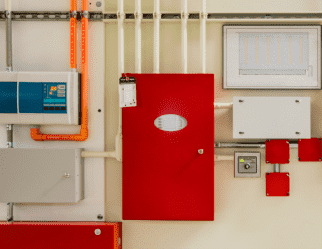School and educational buildings are complicated multi-use buildings with areas that contain unique fire hazards including unmonitored food tech cooking stations, technology and chemistry labs. Though school fires are rare with 1 in 1000 each year according to Zurich insurance, common causes include, arson, accidental fires, neglect of electricals and neglect of fire systems.
Fire Safety Considerations
Regulation and government programs
The Regulatory Reform (Fire Safety) Order 2005 covers all UK fire safety practices for non-domestic premises but doesn’t provide guidance for specific facilities like schools and universities. This guidance comes from Building Regulations 2010 in relation to fire safety and the means of warning and escape of occupants. In terms of the systems themselves, they fall under BS5839-1, a government paper on fire safety design for schools stipulates that this should be no less than a category L2 system. The legislation requires the appointment of a responsible person/s who must complete the Fire Safety Risk Assessment (FSRA), communicate those risks internally, provide legal mandated fire safety training, plan emergency protocols and implement and maintain fire safety measures.
To help schools invest in their buildings the government recently announced a £1.5bn ‘rebuild and repair’ programme which should in turn lead to the introduction of enhanced fire system technology.
Fire safety systems and false alarms
Ensuring a comprehensive fire safety solution is in place is of utmost importance when installing both wired and wireless systems in educational settings. By incorporating a conventional or addressable fire panel and utilising the appropriate fire detection devices in the relevant areas, the risk of false alarms can be significantly reduced. This is particularly crucial as false alarms disrupt valuable teaching time and can lead to unnecessary evacuations. Depending on specific requirements, heat detectors are ideal for kitchen areas, optical detectors are suitable for classrooms, and multi-sensor detectors are recommended for busy corridors or science labs. These multi-sensor detectors allow panel functions to seamlessly switch between smoke and heat detection, optimising safety measures. Standard fire systems for educational institutions typically consist of panels, sirens, associated power supplies, and manual call points. To protect call points from both intentional and accidental operation, protective covers in accordance with BS5839-1:2017 guidelines could help ensure a safe and secure learning environment.
Fire accessories and safety equipment
In addition to the safety system, additional products to conform to regulations are often needed, these may include emergency exit signage, fire decals, logbook and of course safety equipment like fire extinguishers and blankets. It's also important that fire doors in educational establishments are held open in a safe and secure way providing better access and to help with social distancing and ventilation so fire door retainers are often installed.
Emergency lighting and evacuation route signage
As well as emergency exit signage, schools must provide sufficient anti-panic illumination in large open areas and evacuation route lighting in case of supply failure to the normal lighting to allow the safe exit of pupils, staff and parents (and others using the facilities for out-of-hours activities). Kitchens and other high-risk areas need higher emergency light levels to allow the safe shutdown of equipment. British emergency lighting guidelines insist that each individual emergency light and internally illuminated exit sign must be tested every month as well as a full duration test each year to ensure they will operate when needed; this labour-intensive task can be automated with the use of self-contained addressable or central battery emergency lighting systems.
Security Solutions in Schools
Ensuring the safety and security of staff and students is a primary responsibility for schools and other educational facilities. These institutions are legally obligated to provide a secure environment, making security measures crucial. Whether it's protecting against intruders, preventing vandalism or arson incidents, or monitoring and controlling the movement of people, assets, and vehicles, implementing the right security solution is essential in addressing these risks effectively. By investing in appropriate security measures, educational institutions can uphold their duty of care and create a safe and protected environment conducive to learning and growth.
Integrated security solutions
Educational buildings from multi-building primary schools to multi-level universities and colleges may benefit from integrated security systems including access control, video surveillance, intrusion, fire detection and management systems. The use of Internet Protocol (IP) technology, for example IP Video, allows communications across several products creating a connected solution.
Access control systems in education
Schools and further education sites have a need to restrict access both in and out to specific people, be that staff, pupils or support services. Entry points require physical access control so doors can be fitted with door closers and magnetic locks, some sites also can have revolving doors, turnstiles or barriers to limit access to one person at a time. Door entry systems also often include some form of smart lock or entry ID device like a pin reader, RFID, fob, swipe card or smart card reader or in some instances biometric readers. Since Covid there has been more of a trend to contactless door entry systems. Then you have the door controller at the heart of the system these can control when and who has access and can control multiple doors.
Intrusion and perimeter protection
There is a need to protect educational premises from break-ins and theft and intrusion systems in schools are often monitored remotely and connected to an Alarm Receiving Centre (ARC), enabling trained and quick response out of hours. Intruder systems also often incorporate security sirens which alert a person or response service in an emergency. Intruder systems often form part of a wider integrated security solution that combined with motion and perimeter detectors, outdoor lighting, CCTV systems and even gate control and number plate recognition which can provide peace of mind for schools and higher education facilities.
Intruder systems should be compliant with PD 6662:2017 the scheme which enables security systems to be installed and maintained in accordance with published British and European Standards.
ADI provides an extensive selection of fire safety and security solutions to professional installers and system integrators, catering to projects of varying scales within the education sector. Whether it's a single-site early-years setting or a multi-site, multi-level university campus, ADI offers a comprehensive range of products from top-tier suppliers. These products have undergone rigorous testing to ensure compliance with current UK regulations, guaranteeing the highest standards of safety and security for educational institutions. Alongside these products, we also offer help and support with projects from our experienced technical support team who can aid product selection, project design and provide post-sales technical support.








